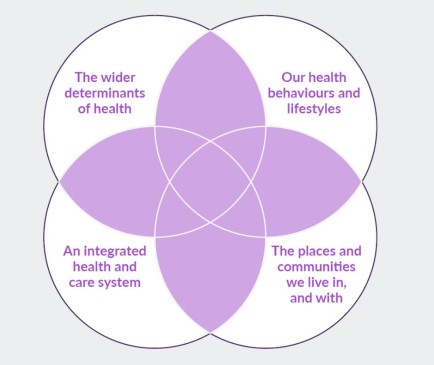Population health
Key points about population health
- Population health is an approach aimed at improving the health of an entire population.
- It addresses ways that resources can be allocated to overcome the problems that drive poor health conditions in the population.

Population health is a new concept aimed at preventing illness and improving the health and wellbeing of local communities. It considers all aspects of health, such as physical, mental and emotional wellbeing, as well as social aspects, including education, employment, housing and more.
There are several definitions of population health from different organisations. The King's Fund, UK defines it as:
"An approach aimed at improving the health of an entire population. It is about improving the physical and mental health outcomes and wellbeing of people within and across a defined local, regional or national population, while reducing health inequalities. It includes action to reduce the occurrence of ill health, action to deliver appropriate health and care services and action on the wider determinants of health. It requires working with communities and partner agencies."
This definition comes from the Centers for Disease Control and Prevention, US:
"An interdisciplinary, customisable approach that allows health departments to connect practice to policy for change to happen locally. This approach utilises non-traditional partnerships among different sectors of the community – public health, industry, academia, healthcare, local government entities, etc. – to achieve positive health outcomes. Population health brings significant health concerns into focus and addresses ways that resources can be allocated to overcome the problems that drive poor health conditions in the population.”
Video: What is population health?
The video below from The King's Fund, UK explains what population health is and how taking a population health approach could improve the health of local communities.
(The King's Fund, UK, 2019)
According to The King's Fund, improving population health requires a focus on the 4 pillars of population health. These are shown in the image below:

Image credit: What does improving population health mean?(external link) The King's Fund, UK
However, to improve population health, the 4 pillars should be seen as a whole system interconnected with each other rather than acting individually. A population health system should look like this:

Image credit: What does improving population health mean?(external link) The King's Fund, UK
Public health is defined as "the art and science of preventing disease, prolonging life and promoting health through the organised efforts of society” (Acheson, WHO, 1988). Therefore, it involves research disease detection and prevention as well as promoting health by public health education.
On the other hand, population health provides "an opportunity for healthcare systems, agencies and organisations to work together in order to improve the health outcomes of the communities they serve.” (Centers for Disease Control and Prevention, US 2019)
To improve population health, changes have to be made at 3 different levels:
- national
- regional
- local.
Read more about what needs to happen at different levels to improve population health(external link).
A vision for population health – towards a healthier future(external link) The King's Fund, UK
What does improving population health mean?(external link) The King's Fund, UK
- What does improving population health mean?(external link) The King's Fund, UK
- Populations, population health, and the evolution of population management – making sense of the terminology in US health care today(external link) Institute for Healthcare Improvement, US
- Public health services(external link) World Health Organization
Reviewed by: Healthify editorial team. Healthify is brought to you by Health Navigator Charitable Trust.
Last reviewed:


